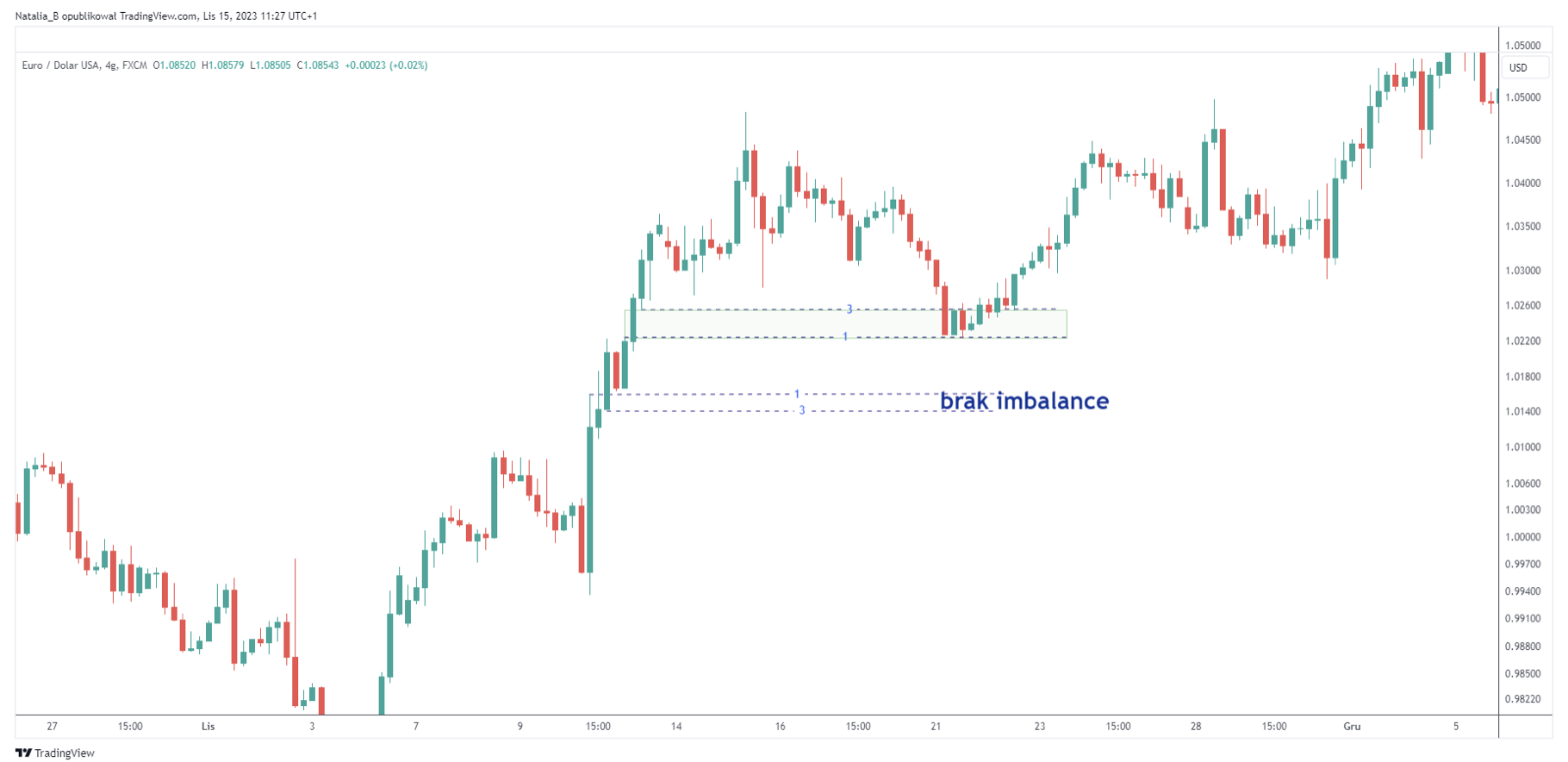Smart Money Concept – What is imbalance?
In the recently published part of the series about Smart Money Concept (SMC) we explained what is trend structure. As a rule, the most interesting aspects of demand and supply lie around changes in the nature of the trend and its continuation - it is related to the confirmation of liquidity. A link to a video that explains this rule can be found at the very end of the article. Today, I will tell you a little more about the SMC structure that we call it imbalance. It can be traded as a completely separate technique. However, I would like to point out at the outset that it works best as an element predicting potential places pullback in a well-defined trend structure.
What is imbalance?
The thing about price is that it goes through some ups and downs. At SMC we interpret movements as these "healthy" i “unequal”. In the pages a book I recently published I pointed to imbalance as an example of the creation of inequality. If the price increases in an unhealthy way, there is an excess of demand or supply, which creates an imbalance. You can also find other names for this phenomenon in the literature, such as: GAP or FVG. Take a look at the graphical diagram below, which we will discuss in a moment.

Examples of IMB in the chart. Source: platform TradingView.
We have two imbalances marked here - the first one with signed numbers 1, 2, 3 and the second one marked with a square with a signature IMB. The latter occurs between the third and fifth candles (it is important to maintain a distance of one candle). Please note that before the breakout of the trend continuation, the deeper imbalance (marked with numbers) was completely filled. Imbalance zawsze is created between the first and third candles.
When determining the imbalance, we take into account:
- the first and third candle (if the impulse has more candles, we can move them to the next ones),
- direction of price movement (consistency with the trend),
- only impulses,
- we draw it along the shadows of the candles - in the upward movement of the high of the first candle and the low of the third; in a downward movement, low of the first candle and high of the third,
- there may be several imbalances in one impulse, as a rule they should be filled before the breakout of the trend continuation.
Imbalance is played:
- according to the trend,
- we are looking for the input in the last (freshest) pulse.
Below is an example of the presence and absence of imbalance. Notice that next to the inscription “no imbalance” the low price of the third candle (this is the opening price in this case) does not create “gaps”. Therefore, this phenomenon does not occur here. This is different in the example above. It occurs between the first and third candle "gap", which is the place where the price stops and the reaction is consistent with the trend.

Examples of the presence and absence of IMB on the chart. Source: platform TradingView.
Summation
Let's remember not to look for an imbalance at the historical price. Inequality of demand and supply is what the market has in common “is arriving” them on a regular basis or just leave them. Our title "hero", as a rule, increases the probability of finding the most interesting demand and supply zones. Its presence will shape us order block – one of the most important and most desirable SMC structures. Thanks to this technique, it is easier to find places to potentially stop the pullback I mentioned in one of the articles from the Smart Money Concept series.
This is the last article in the SMC series. If you are interested in this topic, please read the book "Demand and supply strategy in trading. Introduction to Smart Money Concept” by Natalia Bojko, who describes this methodology in detail in every aspect.






















![Forex Club – Tax 9 – Settle tax on a foreign broker [Download the Application] Forex Club - Tax 9](https://forexclub.pl/wp-content/uploads/2024/02/Forex-Club-Podatek-9-184x120.jpg?v=1709046278)
![Trading View platform – solutions tailored to the needs of traders [Review] trading view review](https://forexclub.pl/wp-content/uploads/2024/03/trading-view-recenzja-184x120.jpg?v=1709558918)
![How to connect your FP Markets account to the Trading View platform [Guide] fp markets trading view](https://forexclub.pl/wp-content/uploads/2024/02/fp-markets-trading-view-184x120.jpg?v=1708677291)
![How to invest in ChatGPT and AI? Stocks and ETFs [Guide] how to invest in chatgpt and artificial intelligence](https://forexclub.pl/wp-content/uploads/2023/02/jak-inwestowac-w-chatgpt-i-sztuczna-inteligencje-184x120.jpg?v=1676364263)


![WeWork – the anatomy of the collapse of a company valued at $47 billion [WeWork, part II] wework bankruptcy story](https://forexclub.pl/wp-content/uploads/2024/04/wework-bankructwo-historia-184x120.jpg?v=1711729561)
![Adam Neumann – the man who screwed up Softbank [WeWork, part AND] adam neumann wework](https://forexclub.pl/wp-content/uploads/2024/04/adam-neumann-wework-184x120.jpg?v=1711728724)





![How to transfer shares to another brokerage office [Procedure description] how to transfer shares to another brokerage house](https://forexclub.pl/wp-content/uploads/2024/03/jak-przeniesc-akcje-do-innego-biura-maklerskiego-184x120.jpg?v=1709556924)

![The most common mistakes of a beginner trader - Mr Yogi [VIDEO] Scalping - The most common mistakes of a beginner trader - VIDEO](https://forexclub.pl/wp-content/uploads/2024/03/Scalping-Najczestsze-bledy-poczatkujacego-tradera-VIDEO-184x120.jpg?v=1711601376)
![Learning patience: No position is also a position - Mr Yogi [VIDEO] Scalping - Learning patience - No position is also a position - VIDEO](https://forexclub.pl/wp-content/uploads/2024/03/Scalping-Nauka-cierpliwosci-Brak-pozycji-to-tez-pozycja-VIDEO-184x120.jpg?v=1710999249)
![When to exit a position and how to minimize losses - Mr Yogi [VIDEO] Scalping - When to exit a position and how to minimize losses - VIDEO](https://forexclub.pl/wp-content/uploads/2024/03/Scalping-Kiedy-wyjsc-z-pozycji-i-jak-minimalizowac-straty-VIDEO-184x120.jpg?v=1710336731)




![Trading View platform – solutions tailored to the needs of traders [Review] trading view review](https://forexclub.pl/wp-content/uploads/2024/03/trading-view-recenzja-300x200.jpg?v=1709558918)

![The most common mistakes of a beginner trader - Mr Yogi [VIDEO] Scalping - The most common mistakes of a beginner trader - VIDEO](https://forexclub.pl/wp-content/uploads/2024/03/Scalping-Najczestsze-bledy-poczatkujacego-tradera-VIDEO-300x200.jpg?v=1711601376)











